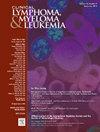Real-Life Management of Patients Aged 80 Years Old and Over With Multiple Myeloma: Results of the EMMY Cohort
IF 2.7
4区 医学
Q2 HEMATOLOGY
引用次数: 0
Abstract
Introduction
Multiple myeloma patients aged 80 years and older are a population more prone to comorbidities and frailty. We aim to describe the real-life management and outcomes of this population. EMMY is a descriptive large-scale study.
Patients
Between 2017 and 2021 we included 4383 patients of which 894 (20.3%) were aged ≥ 80 years. Four cohorts of patients aged ≥ 80 years were analysed: line 1 (L1), line 2 (L2), line 3 (L3) or line 4+ (L4+).
Results
The proportion of patients ≥ 80 years old was 20.8% in L1, 21.3% in L2, 20.9% in L3 and 17.8% in L4+. L1 patients received more treatment including a proteasome inhibitor (PI) (42.9%), L2 patients received mainly an immunomodulator (IMID) (65.9%) or an anti-CD38 (31.5%). For L3, IMID was used in 71.4% than an anti-CD38 (33.5%). L4+ patients received a PI (40.6%), IMID (33.2%) or an anti-CD38 (29.1%). Regarding efficacy, the median progression-free survival was 18.4 months in L1, 15.1 months in L2, 10.4 months in L3 and 6.5 months in L4+. The median overall survival was 49 months in L1, 31.3 months in L2, 21.4 months in L3 and 13.6 months in L4+.
Conclusion
EMMY cohort confirmed that patients ≥ 80 years of age represent an important proportion of MM patients, in the de novo or relapse setting. This study is an important step in improving our comprehension and management of treatment in elderly patients.
80 岁及以上多发性骨髓瘤患者的实际管理:EMMY队列的结果。
导言80 岁及以上的多发性骨髓瘤患者更容易出现合并症和虚弱。我们旨在描述这一人群的实际管理和治疗效果。EMMY是一项描述性大规模研究:2017年至2021年间,我们纳入了4383名患者,其中894人(20.3%)年龄≥80岁。对年龄≥80岁的患者进行了四组分析:1号线(L1)、2号线(L2)、3号线(L3)或4+号线(L4+):L1线≥80岁患者的比例为20.8%,L2线为21.3%,L3线为20.9%,L4+线为17.8%。L1患者接受的治疗较多,包括蛋白酶体抑制剂(PI)(42.9%),L2患者主要接受免疫调节剂(IMID)(65.9%)或抗CD38(31.5%)。L3患者中,71.4%使用了IMID,33.5%使用了抗CD38。L4+患者接受了PI(40.6%)、IMID(33.2%)或抗CD38(29.1%)治疗。在疗效方面,L1患者的中位无进展生存期为18.4个月,L2患者为15.1个月,L3患者为10.4个月,L4+患者为6.5个月。L1患者的中位总生存期为49个月,L2患者为31.3个月,L3患者为21.4个月,L4+患者为13.6个月:EMMY队列证实,在新发或复发的MM患者中,年龄≥80岁的患者占很大比例。这项研究为我们更好地理解和管理老年患者的治疗迈出了重要一步。
本文章由计算机程序翻译,如有差异,请以英文原文为准。
求助全文
约1分钟内获得全文
求助全文
来源期刊

Clinical Lymphoma, Myeloma & Leukemia
ONCOLOGY-HEMATOLOGY
CiteScore
2.70
自引率
3.70%
发文量
1606
审稿时长
26 days
期刊介绍:
Clinical Lymphoma, Myeloma & Leukemia is a peer-reviewed monthly journal that publishes original articles describing various aspects of clinical and translational research of lymphoma, myeloma and leukemia. Clinical Lymphoma, Myeloma & Leukemia is devoted to articles on detection, diagnosis, prevention, and treatment of lymphoma, myeloma, leukemia and related disorders including macroglobulinemia, amyloidosis, and plasma-cell dyscrasias. The main emphasis is on recent scientific developments in all areas related to lymphoma, myeloma and leukemia. Specific areas of interest include clinical research and mechanistic approaches; drug sensitivity and resistance; gene and antisense therapy; pathology, markers, and prognostic indicators; chemoprevention strategies; multimodality therapy; and integration of various approaches.
 求助内容:
求助内容: 应助结果提醒方式:
应助结果提醒方式:


